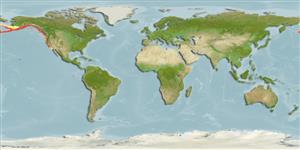Environment: milieu / climate zone / depth range / distribution range
Ecología
marino demersal; rango de profundidad 10 - 1370 m (Ref. 50610). Temperate; 65°N - 31°N, 178°E - 117°W
Eastern Pacific: Navarin Canyon in the Bering Sea to Stalemate Bank in the Aleutian Islands and San Cristobal Bay, Baja California, Mexico.
Length at first maturity / Tamaño / Peso / Age
Maturity: Lm 38.5, range 38 - 40 cm
Max length : 76.0 cm TL macho / no sexado; (Ref. 2850); common length : 40.0 cm TL macho / no sexado; (Ref. 56527); peso máximo publicado: 3.5 kg (Ref. 56527); edad máxima reportada: 56 años (Ref. 74500)
Espinas dorsales (total): 0; Radios blandos dorsales (total): 90-116; Espinas anales 0; Radios blandos anales: 80 - 96; Vértebra: 50 - 54. Dorsal origin above middle of upper eye. Caudal imperfectly rounded.
Adults occur on mud bottom (Ref. 2850). They move into deep water in winter (Ref. 2850). Produce large amounts of slime which may cover other fishes when caught in trawls (Ref. 4925). Marketed as mink food (Ref. 4925) or as fillet (Ref. 2850).
Vinnikov, K.A., R.C. Thomson and T.A. Munroe, 2018. Revised classification of the righteye flounders (Teleostei: Pleuronectidae) based on multilocus phylogeny with complete taxon sampling. Molecular phylogenetics and evolution, 125:147-162. (Ref. 122998)
IUCN Red List Status (Ref. 130435)
Threat to humans
Harmless
Human uses
Pesquerías: comercial; pesca deportiva: si
Herramientas
Special reports
Download XML
Fuentes de Internet
Estimates based on models
Preferred temperature (Ref.
123201): 1.1 - 6.3, mean 3.5 °C (based on 248 cells).
Phylogenetic diversity index (Ref.
82804): PD
50 = 0.5625 [Uniqueness, from 0.5 = low to 2.0 = high].
Bayesian length-weight: a=0.00646 (0.00367 - 0.01135), b=3.07 (2.91 - 3.23), in cm total length, based on LWR estimates for this species & (Sub)family-body (Ref.
93245).
Nivel trófico (Ref.
69278): 3.2 ±0.1 se; based on diet studies.
Resiliencia (Ref.
120179): Bajo, población duplicada en un tiempo mínimo de 4.5-14 años (tm=5; tmax=56; K=0.26; Fec=37,000).
Prior r = 0.35, 95% CL = 0.23 - 0.52, Based on 3 stock assessments.
Fishing Vulnerability (Ref.
59153): High to very high vulnerability (71 of 100).
Climate Vulnerability (Ref.
125649): Moderate vulnerability (43 of 100).
Nutrients (Ref.
124155): Calcium = 14.7 [8.7, 29.4] mg/100g; Iron = 0.211 [0.121, 0.389] mg/100g; Protein = 16.7 [14.7, 18.8] %; Omega3 = 0.337 [0.163, 0.715] g/100g; Selenium = 27.8 [13.8, 59.9] μg/100g; VitaminA = 7.77 [1.73, 33.10] μg/100g; Zinc = 0.373 [0.269, 0.554] mg/100g (wet weight); based on
nutrient studies.
